Kanchanaburi province is located in western Thailand near the border of Myanmar. It is a beautiful and diverse natural habitat that is home to a wide variety of birds.
There are over 400 species of birds found in Kanchanaburi, ranging from water birds such as kingfishers and egrets to raptors like hawks and vultures.
Kanchanaburi is also a great destination for birdwatchers, as there are several national parks and wildlife sanctuaries that offer amazing opportunities to observe and photograph birds in their natural habitat.
From the colorful wild jungle birds of the Thungyai-Huai Kha Khaeng Wildlife Sanctuaries to the migratory birds of the Sai Yok and Kaeng Krachan National Parks, Kanchanaburi is home to a unique and vibrant avian population that is sure to delight any bird enthusiast.
1. Pheasant-tailed Jacana
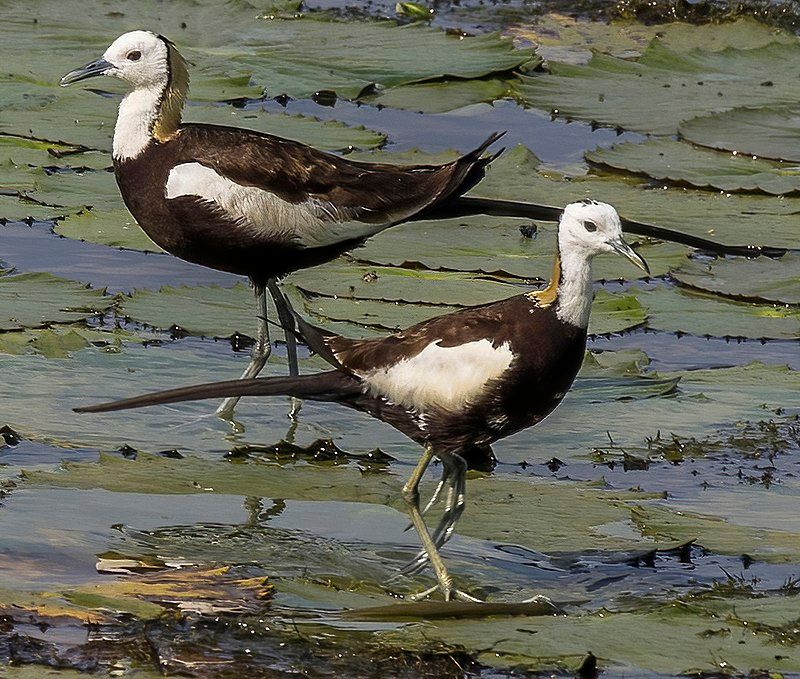
The pheasant-tailed jacana is a type of bird found in the monotypic genus Hydrophasianus. These birds are unique amongst their species due to their elongated toes and nails.
This physical adaptation makes it possible for the pheasant-tailed jacana to navigate and walk on floating vegetation in shallow lakes. This type of environment is their preferred habitat, as it provides the birds with the necessary resources to survive.
These birds have evolved to take advantage of this specific type of habitat, as it provides them with shelter, food, and protection from predators. The pheasant-tailed jacana is an impressive species, as it has adapted to its environment in order to thrive.
| Kingdom | Animalia |
| Phylum | Chordata |
| Class | Aves |
| Order | Charadriiformes |
| Family | Jacanidae |
| Genus | Hydrophasianus |
| Species | H. chirurgus |
2. Spotted Dove
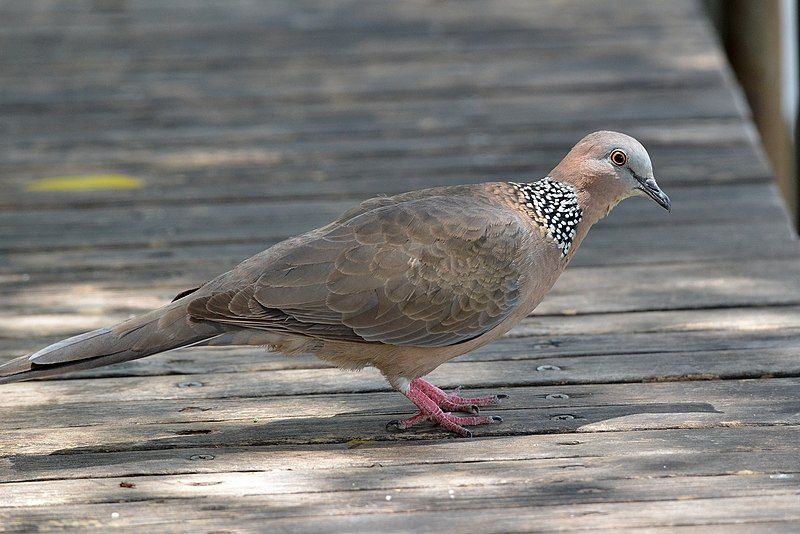
The spotted dove is a small, long-tailed pigeon that is a widely distributed species native to the Indian subcontinent and Southeast Asia. It is a common breeding bird in its native range and has even been introduced to many other areas of the world.
As a result, feral populations of the species have become established in some of these areas. The spotted dove is easy to identify due to its distinctive spotted pattern and long tail.
This species is also known for its loud, repetitive calls that can be heard from some distance away. It is a ground-feeding bird, which means it forages for food on the ground. It feeds on seeds, insects, and other small invertebrates.
The spotted dove is also popular as a caged bird and is kept as a pet in many parts of the world.
| Kingdom | Animalia |
| Phylum | Chordata |
| Class | Aves |
| Order | Columbiformes |
| Family | Columbidae |
| Genus | Spilopelia |
| Species | S. chinensis |
3. White-breasted Waterhen
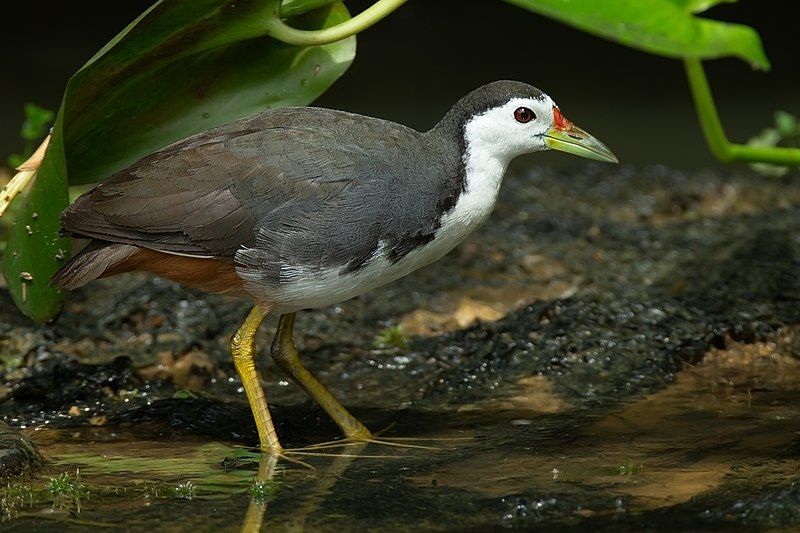
The white-breasted waterhen is an aquatic bird belonging to the Rallidae family. These birds are known for their dark slaty feathers and distinguished white facial markings, which extend from their face to their chest and belly.
They are found in regions of South and Southeast Asia, making them one of the most widely distributed waterbirds in the region. White-breasted waterhens typically prefer shallow wetland habitats, such as swamps, marshes, and flooded grasslands.
They also inhabit the edges of ponds, lakes, and rivers, where they are able to feed on seeds, insects, and small animals. It is common for them to forage in small flocks, which can help them to spot predators and keep them safe.
These birds are quite large compared to other members of the rail and crake family. They have long, grey-brown wings and a long, slim body which is well-adapted for swimming. The white-breasted water can be seen perched on vegetation or wading through shallow water.
They are also known to be quite vocal, with a variety of clucking, croaking, and cackling sounds. The white-breasted waterhen is an important species for wetland ecosystems in South and Southeast Asia.
They help to control insect populations, provide food for other species and improve water quality by aerating and stirring up the sediment. They are a protected species in many parts of their range and are an important part of the aquatic habitat.
| Kingdom | Animalia |
| Phylum | Chordata |
| Class | Aves |
| Order | Gruiformes |
| Family | Rallidae |
| Genus | Amaurornis |
| Species | A. phoenicurus |
4. Lesser Whistling Duck
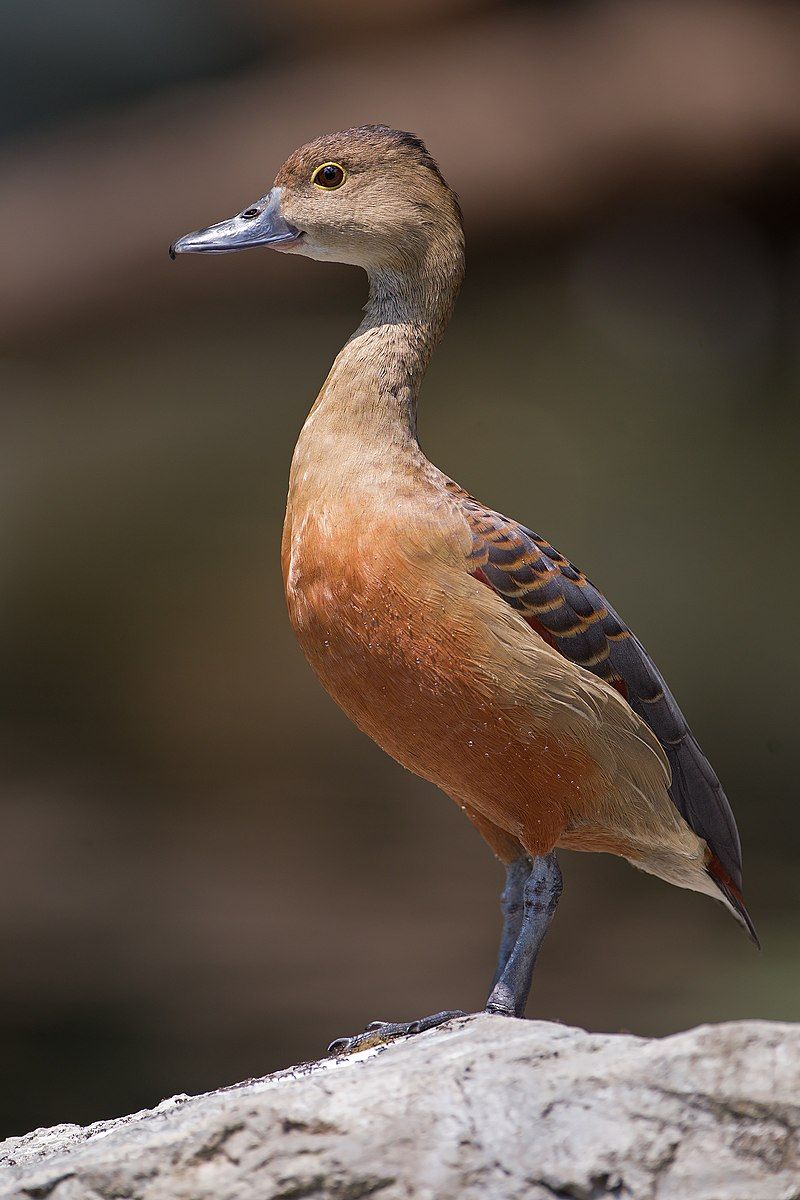
The lesser whistling duck is a species of duck native to the Indian subcontinent and Southeast Asia. It is also known as the Indian whistling duck or lesser whistling teal. These ducks are nocturnal feeders, which means they feed mainly at night.
During the day they can be found in large flocks around lakes and wet paddy fields. They are social animals and often flock together in large groups. The lesser whistling duck is an important species in the region, as it helps to maintain the health of its local ecosystems.
It feeds on aquatic plants, insects, and small fish, which helps to keep aquatic habitats balanced. It is also an important source of food for many predators, such as owls, eagles, and herons.
The lesser whistling duck is an important part of the region’s biodiversity, and its presence is essential for the health of its local ecosystems.
| Kingdom | Animalia |
| Phylum | Chordata |
| Class | Aves |
| Order | Anseriformes |
| Family | Anatidae |
| Genus | Dendrocygna |
| Species | D. javanica |
5. Plaintive Cuckoo
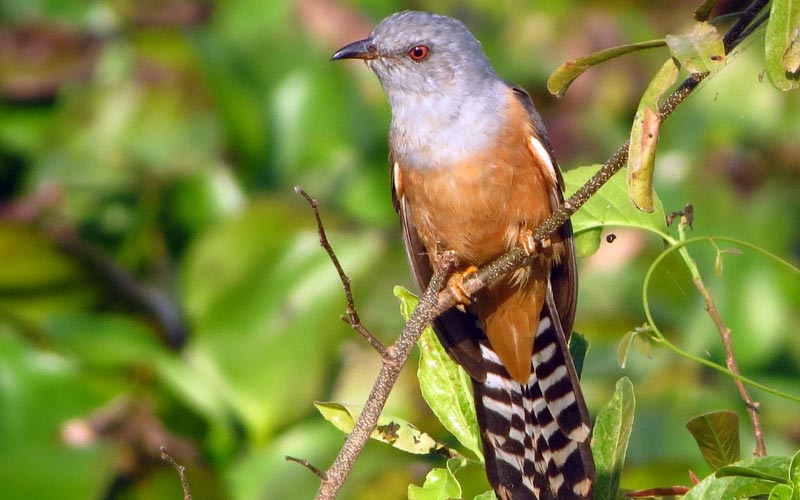
Source: ebird.org
The plaintive cuckoo is a species of bird that belongs to its own genus, Cacomantis, which is part of the cuckoo family Cuculidae. This species of bird is native to the continent of Asia, spanning from India, Nepal, and China to Indonesia.
Its distribution is quite large, making it one of the most commonly seen birds in this region. The plaintive cuckoo has a distinct call that makes it easily identifiable. It is a two-note call that sounds like “cu-cu” and can be heard from a distance.
Its feathers are mostly a combination of grey, pale brown, and white, allowing it to blend in with its natural environment. It can be found in a variety of habitats, from open woodlands, to grasslands, and even in agricultural areas.
The plaintive cuckoo is an insectivore, feeding mainly on caterpillars, grasshoppers, and other small insects. It can also feed on berries, seeds, and other plant matter. It is a solitary bird and usually nests in the forks of trees or in dense shrubs.
The female usually lays two to three eggs in a single clutch. The plaintive cuckoo is an important part of the ecosystem in Asia, helping to maintain a balance between insect populations and other species of birds.
| Kingdom | Animalia |
| Phylum | Chordata |
| Class | Aves |
| Order | Cuculiformes |
| Family | Cuculidae |
| Genus | Cacomantis |
| Species | C. merulinus |
6. Green-billed Malkoha
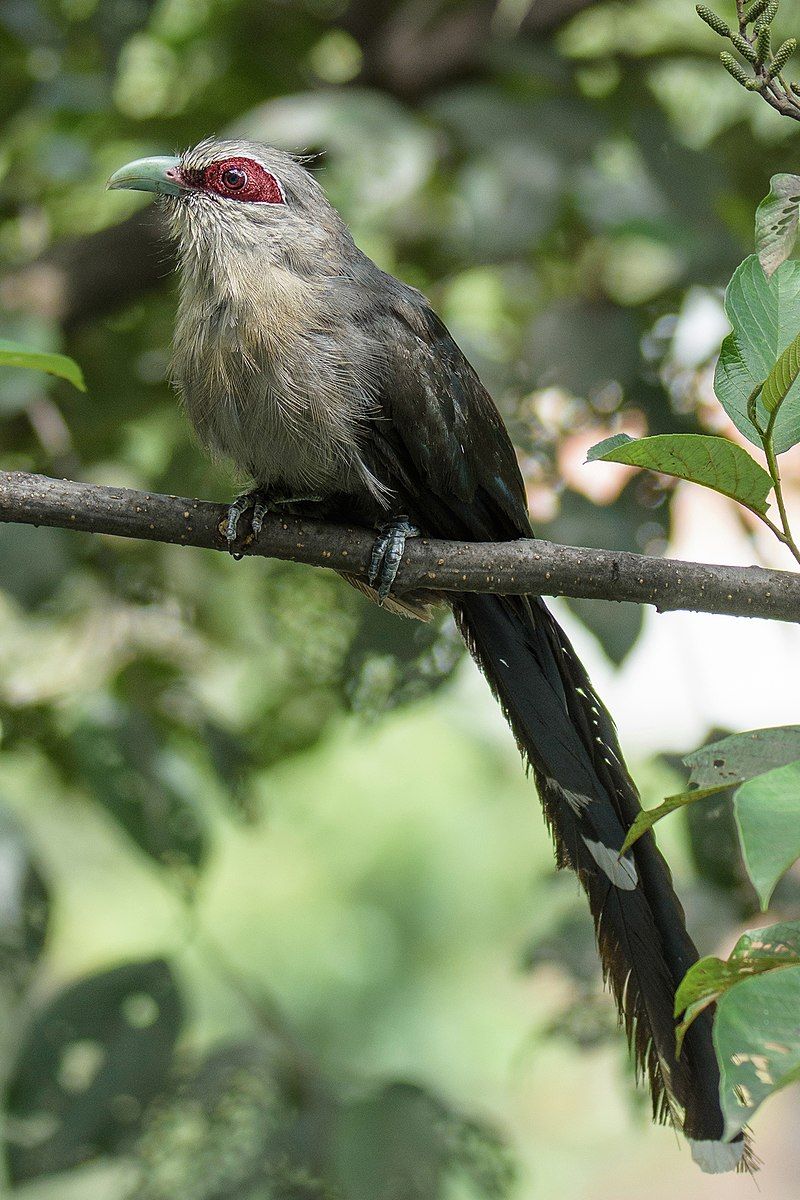
The green-billed malkoha is a species of non-parasitic cuckoo that inhabits the Indian Subcontinent and Southeast Asia.
These birds are known for their distinct physical characteristics, such as their waxy bluish-black feathers, long graduated tails with white tips, and prominent curved bills.
The green-billed malkoha is typically found in dry scrub and thin forests, where its camouflage helps it hide from predators. These birds are omnivorous, meaning they consume both plant and animal matter. Their diet consists of insects, fruits, small reptiles, and small mammals.
They have also been known to feed on nectar and flower buds.
The green-billed malkoha is a solitary bird and is rarely seen in large flocks. The green-billed malkoha is an important part of the ecosystem, as it helps to keep insect populations in check, as well as disperse seeds of fruit trees and plants in its travels.
Unfortunately, the population of these birds has been declining due to habitat loss and degradation, as well as capture for the pet trade. Conservation efforts are underway in order to protect the green-billed Malkoha and its habitat.
| Kingdom | Animalia |
| Phylum | Chordata |
| Class | Aves |
| Order | Cuculiformes |
| Family | Cuculidae |
| Genus | Phaenicophaeus |
| Species | P. tristis |
7. Indian Roller
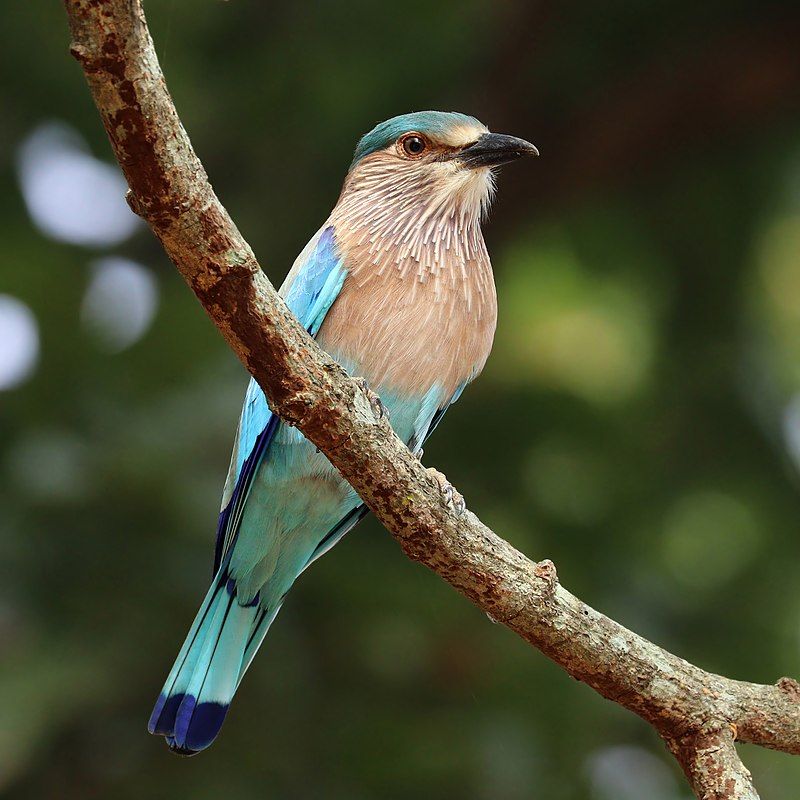
The Indian roller is a bird of the family Coraciidae. It is a beautiful bird, approximately 30–34 cm in length with a wingspan of 65–74 cm and weighing 166–176 g. The face and throat of the Indian roller have a bright pinkish hue, while its head and back are a light brown color.
The bird’s rump is a deep blue, and its wings and tail have a stunning contrast of light and dark blue. It’s a bird that is sure to draw attention wherever it may be seen. Its small size and vibrant colors make it an impressive sight in the sky.
| Kingdom | Animalia |
| Phylum | Chordata |
| Class | Aves |
| Order | Coraciiformes |
| Family | Coraciidae |
| Genus | Coracias |
| Species | C. benghalensis |
8. Red-wattled Lapwing
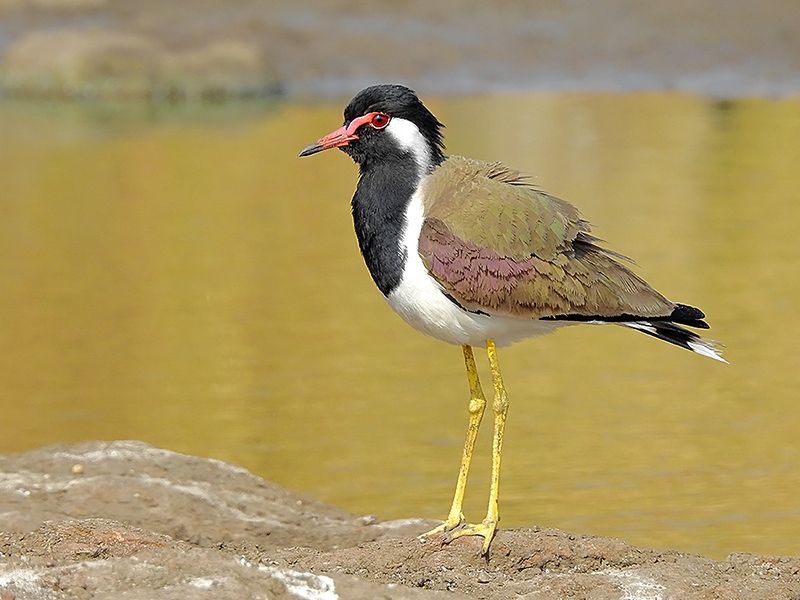
The red-wattled lapwing is a species of wading bird that belongs to the family Charadriidae. Commonly found in Asia, the red-wattled lapwing is a large plover. It belongs to the family of lapwings and is therefore a ground bird, meaning it is unable to perch like other birds.
It is most commonly found in grasslands, fields, and wetlands, where it feeds on insects, worms, and other invertebrates. The red-wattled lapwing is easily recognized by its distinctive red wattles on either side of its head and its characteristic call.
The wattles are bright red and very noticeable, even from a distance.
Its call is loud and distinctive, consisting of a series of shrill whistles that can be heard up to a kilometer away. The red-wattled lapwing is an important species in some parts of its range, particularly in India where it is used as an indicator of wetland health.
It is also a popular game bird, with a large home range and the ability to fly long distances. The red-wattled lapwing is a highly social bird and often forms large flocks. It is also a very protective species, with both parents taking an active role in raising their young.
They have been observed defending their nests aggressively from predators, even to the point of attacking humans and other animals that come too close.
| Kingdom | Animalia |
| Phylum | Chordata |
| Class | Aves |
| Order | Charadriiformes |
| Family | Charadriidae |
| Genus | Vanellus |
| Species | V. indicus |
9. Greater Racket-tailed Drongo
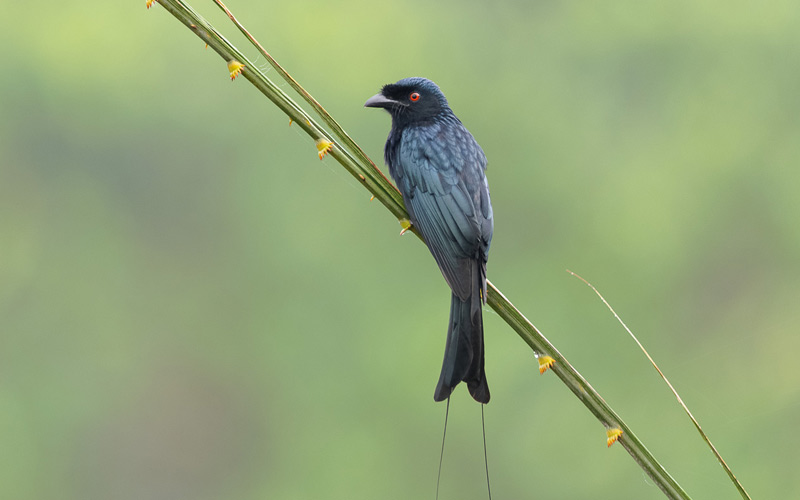
Source: singaporebirds.com
The greater racket-tailed drongo is a medium-sized bird that can be found in various parts of Asia. It is a distinctive bird, with elongated outer tail feathers which have webbing restricted to the tips.
This species belongs to the family Dicruridae, which is a family of birds known as drongos and includes other species such as the black drongo and the ashy drongo. The greater racket-tailed drongo is an omnivore and feeds on a variety of insects, fruits, and small reptiles.
It has a unique set of adaptations that allows it to thrive in many different habitats, from open forests to wetlands. The drongo has a very agile flight and is able to maneuver in tight spaces.
The elongated tail feathers help the bird balance when it is flying. The greater racket-tailed drongo is considered to be an important species in terms of its role in the local ecology. It is known to feed on pests such as locusts and grasshoppers, which can damage crops.
It is also known to act as a sentinel, as its loud call can be used to alert other birds to the presence of potential predators. Overall, the greater racket-tailed drongo is a unique and fascinating bird.
Its long and distinctive tail feathers make it easily recognizable, and its abilities to adapt to a variety of habitats make it a valuable species in Asia.
| Kingdom | Animalia |
| Phylum | Chordata |
| Class | Aves |
| Order | Passeriformes |
| Family | Dicruridae |
| Genus | Dicrurus |
| Species | D. paradiseus |
10. Zebra Dove
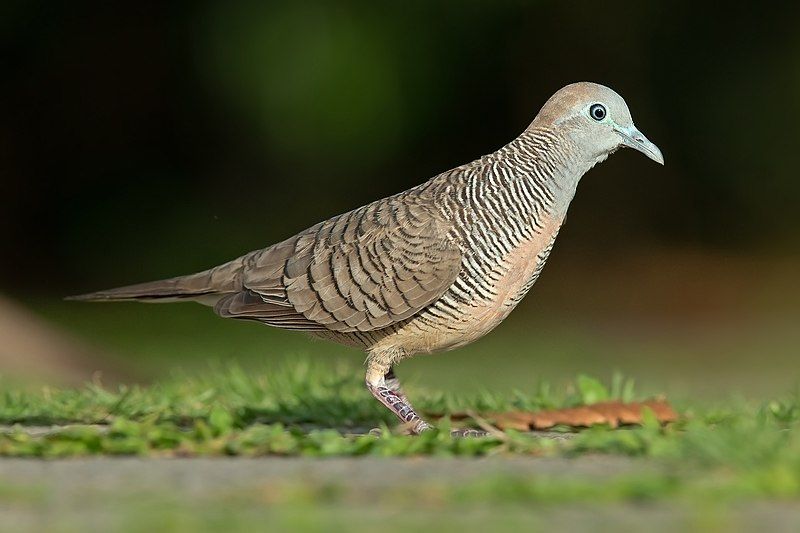
The zebra dove is a species of bird in the dove family Columbidae. It is native to Southeast Asia and is easily recognizable due to its unique pattern of black-and-white barring.
It is a small bird, with a long tail and a predominantly brownish-grey body color. The zebra dove is found in a variety of habitats including lowland forests and open woodlands. It feeds mainly on seeds, fruits, and insects.
It is a social bird and can often be seen in flocks of up to 30 individuals, foraging and roosting together.
It is also quite vocal, with a series of cooing noises often heard during the breeding season. The zebra dove is an important species in its native range, providing food for many predators.
It is also an important seed disperser, helping to spread plants and trees throughout Southeast Asia. Unfortunately, the zebra dove is threatened by habitat destruction and is becoming increasingly rare in many parts of its range.
Conservation efforts are needed to help protect this species and its habitats for future generations.
| Kingdom | Animalia |
| Phylum | Chordata |
| Class | Aves |
| Order | Columbiformes |
| Family | Columbidae |
| Genus | Geopelia |
| Species | G. striata |
11. Black-winged Stilt
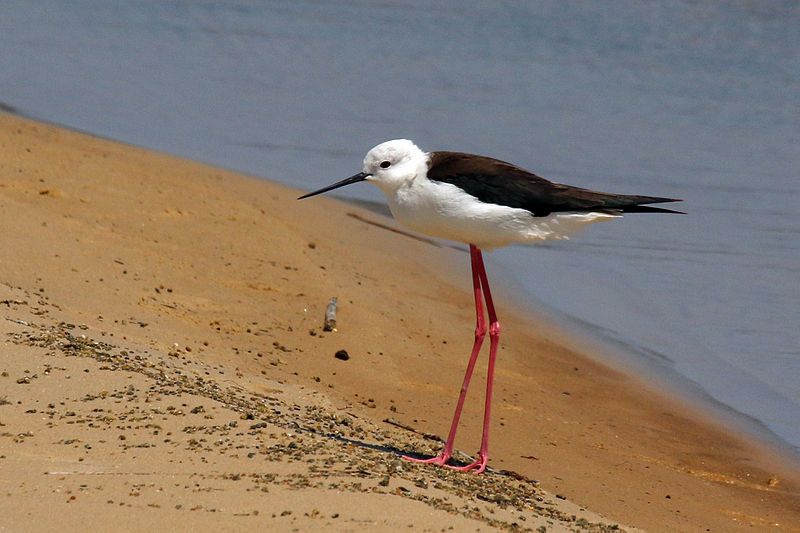
The black-winged stilt is a type of wading bird that is part of the avocet and stilt family. It is widely distributed, meaning that it can be found in multiple regions around the world. These birds have very long legs, which help them navigate the shallow waters they inhabit.
Their scientific name is H. himantopus, and this name can refer to a single species that is almost cosmopolitan in range, meaning that it can be found in many different parts of the world.
The black-winged stilt is an important part of the ecosystems in which it lives, and its presence is essential in helping maintain a balanced and healthy environment.
| Kingdom | Animalia |
| Phylum | Chordata |
| Class | Aves |
| Order | Charadriiformes |
| Family | Recurvirostridae |
| Genus | Himantopus |
| Species | H. himantopus |
12. Black-crowned Night Heron
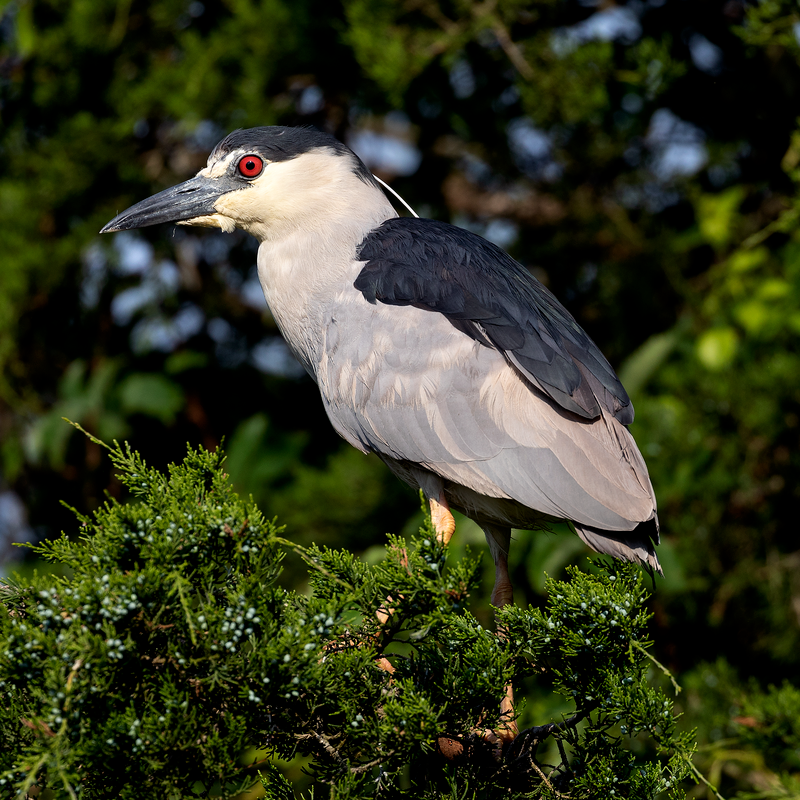
The black-crowned night heron is a species of heron found in many parts of the world. It has a black crown and is often referred to simply as a night heron in Eurasia. It is a medium-sized heron, measuring around 56-71 cm from beak to tail.
This heron inhabits a wide range of habitats, from wetlands and rivers to marshes, woodlands, and grasslands. It is found in parts of Europe, Asia, and the Americas, from Alaska in the north to Argentina in the south.
The black-crowned night heron uses its long, sharp bill to hunt for fish, insects, small mammals, and sometimes even small reptiles. It is a solitary bird and is typically found alone or in small groups.
During the breeding season, the male and female will build a nest in trees or reed beds and lay two to five eggs. The chicks are born with grey down and brown stripes, and they become more brightly colored as they age.
The black-crowned night heron is an important species in many parts of the world. It is a valuable predator in wetlands, helping to keep the insect and fish populations in balance. It also serves as an important food source for other animal species.
The species is classified as of ‘Least Concern’ by the IUCN, however, it is threatened by habitat destruction and pollution.
| Kingdom | Animalia |
| Phylum | Chordata |
| Class | Aves |
| Order | Pelecaniformes |
| Family | Ardeidae |
| Genus | Nycticorax |
| Species | N. nycticorax |
13. Asian koel
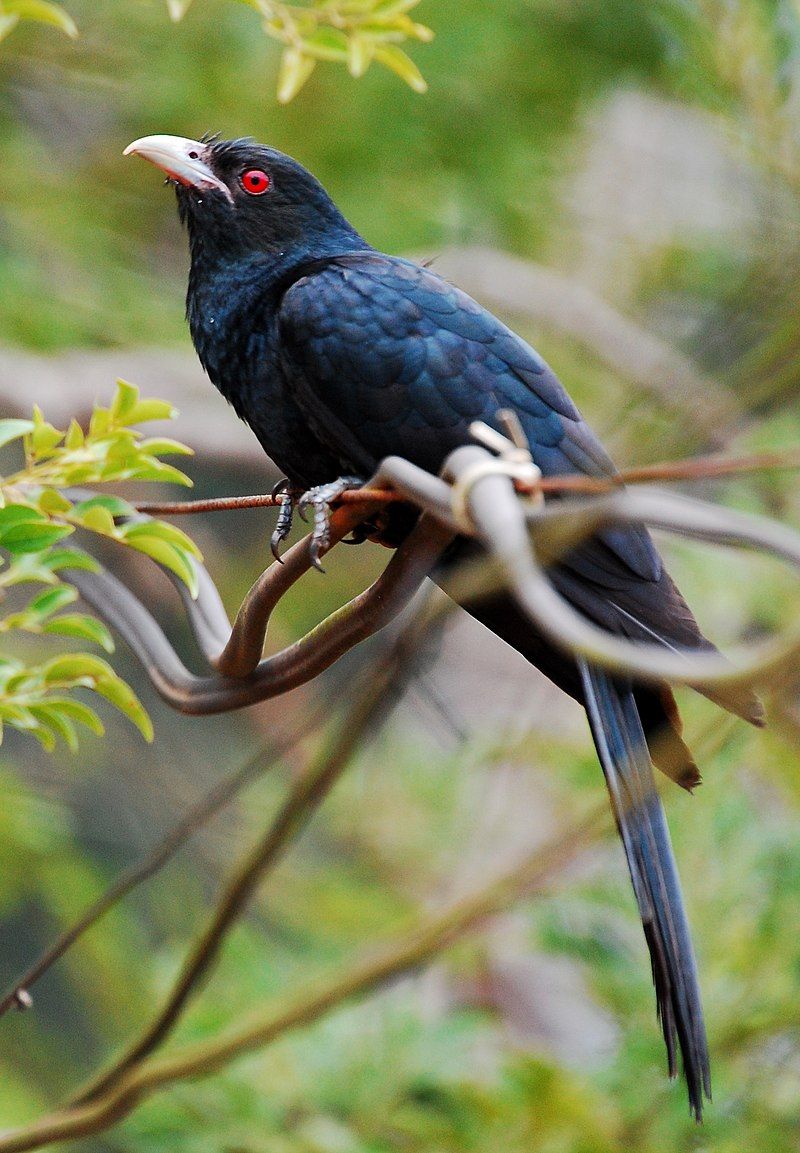
The Asian koel is a species of bird from the Cuculiformes order, commonly known as cuckoos. It can be found in various parts of the Indian Subcontinent, China, and Southeast Asia.
It is closely related to the black-billed koel and the Pacific koel, with which it forms a superspecies.
In some cases, the black-billed koel and the Pacific koel are classified as subspecies of the Asian koel. The Asian koel is a medium-sized bird with glossy black plumage and a distinctive white patch on its wings. It has a long, curved bill and a long tail.
Its song is a loud, repetitive “koo-koo-koo” sound, hence its name. The Asian koel is a solitary bird, preferring to live and feed alone. It is an omnivore and its diet consists of fruits, insects, and small animals.
It also often visits bird feeders. The Asian koel is a brood parasite, meaning it lays its eggs in the nests of other species, such as crows and doves. The host birds unknowingly rear the Asian koel’s offspring. The Asian koel is a common species and is not threatened as of yet.
However, its population has been declining due to the destruction of its natural habitat, as well as hunting by humans. Conservation efforts are underway to protect the species and its habitat.
| Kingdom | Animalia |
| Phylum | Chordata |
| Class | Aves |
| Order | Cuculiformes |
| Family | Cuculidae |
| Genus | Eudynamys |
| Species | E. scolopaceus |
14. Asian Palm Swift
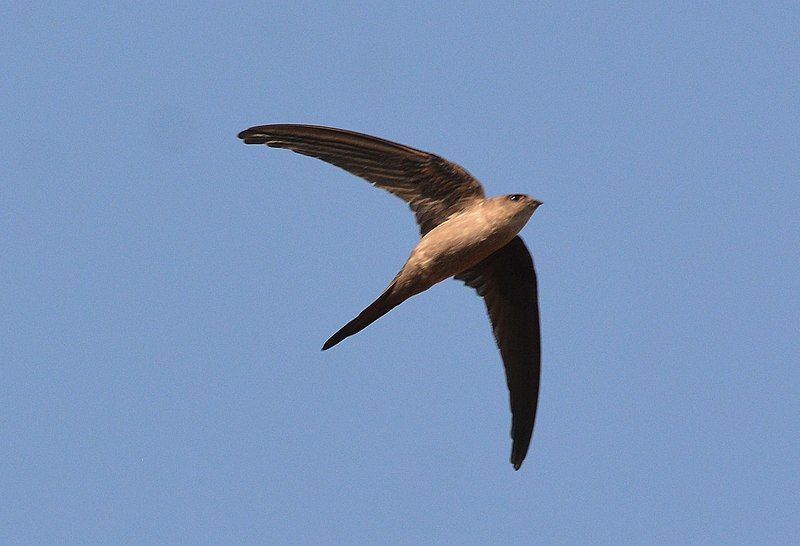
The Asian palm swift is a small bird, belonging to the swift family, which is found in tropical Asia, ranging from India to the Philippines.
It is similar in appearance to the African palm swift, also known as Cypsiurus parvus, and was previously thought to be a part of the same species.
This bird is a common breeding resident in its range, meaning that it stays in the same area for the majority of the year and breeds there as well. It is an important part of the local ecosystem, helping to control insect populations and providing food for other animals.
Its small size also makes it an important part of the food web, providing food for larger birds.
| Kingdom | Animalia |
| Phylum | Chordata |
| Class | Aves |
| Clade | Strisores |
| Order | Apodiformes |
| Family | Apodidae |
| Genus | Cypsiurus |
| Species | C. balasiensis |
15. Chinese Pond Heron
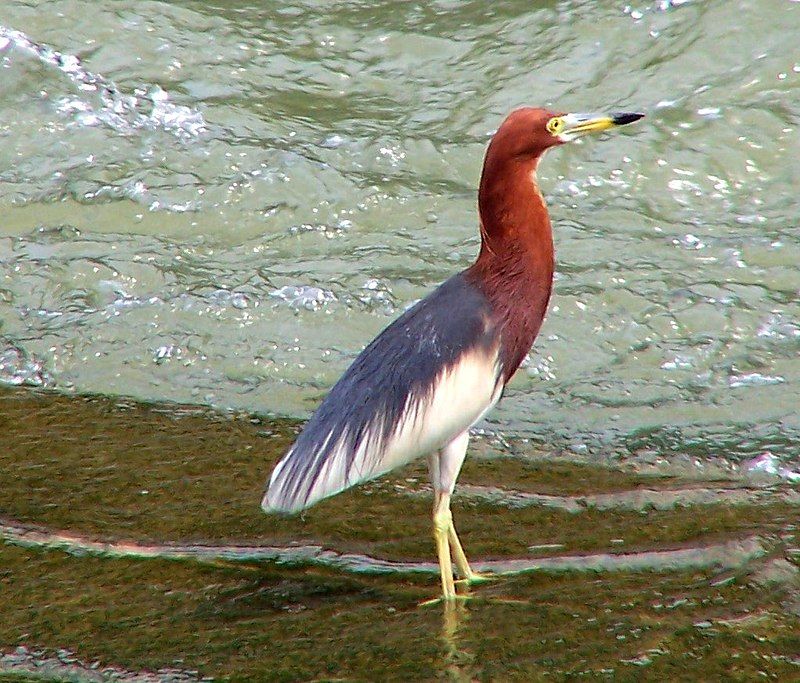
The Chinese pond heron is an East Asian bird of the heron family that can be found near freshwater bodies. It is one of six species of birds that are collectively referred to as “pond herons”.
It is closely related to two other species of pond herons, the Indian pond heron and the Javan pond heron. All three of these species are believed to form a single superspecies, meaning that they are part of the same species but have adapted to live in different habitats.
The Chinese pond heron is found in a range that is parapatric (close but not overlapping) with the Indian pond heron to the west and the Javan pond heron to the south. This is an example of adaptive radiation, where a species has evolved to specialize in different areas.
| Kingdom | Animalia |
| Phylum | Chordata |
| Class | Aves |
| Order | Pelecaniformes |
| Family | Ardeidae |
| Genus | Ardeola |
| Species | A. bacchus |
16. Banded Bay Cuckoo
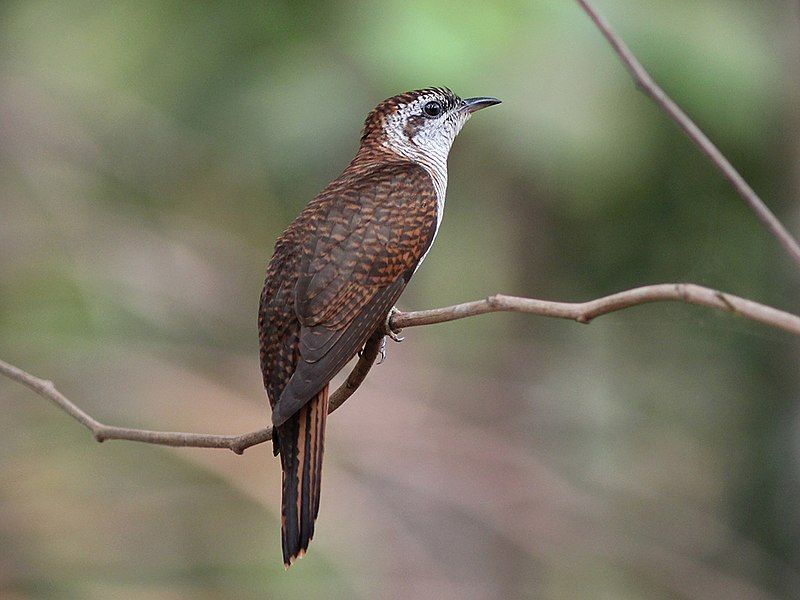
The banded bay cuckoo, also known as the bay-banded cuckoo, is a species of small cuckoo that is found in the Indian subcontinent and Southeast Asia. It is characterized by its round nostril, which is a common feature among members of its genus.
The banded bay cuckoo is usually spotted in well-wooded areas, particularly in the lower hills. This species of cuckoo is known to be quite shy and elusive, so it is often difficult to observe it in its natural habitat.
Nevertheless, its presence in well-wooded areas makes it easier to spot. The banded bay cuckoo has a wide range of habitats, from the Indian subcontinent to Southeast Asia.
It prefers to stay in forests with thick vegetation, such as evergreen forests, deciduous forests, and tropical rainforests. The diet of the banded bay cuckoo consists mostly of insects and small mammals, such as mice and lizards.
They also feed on fruits and berries when available. The banded bay cuckoo is an important species to the local ecology, as it helps to control insect and small mammal populations.
| Kingdom | Animalia |
| Phylum | Chordata |
| Class | Aves |
| Order | Cuculiformes |
| Family | Cuculidae |
| Genus | Cacomantis |
| Species | C. sonneratii |
17. White-throated Kingfisher
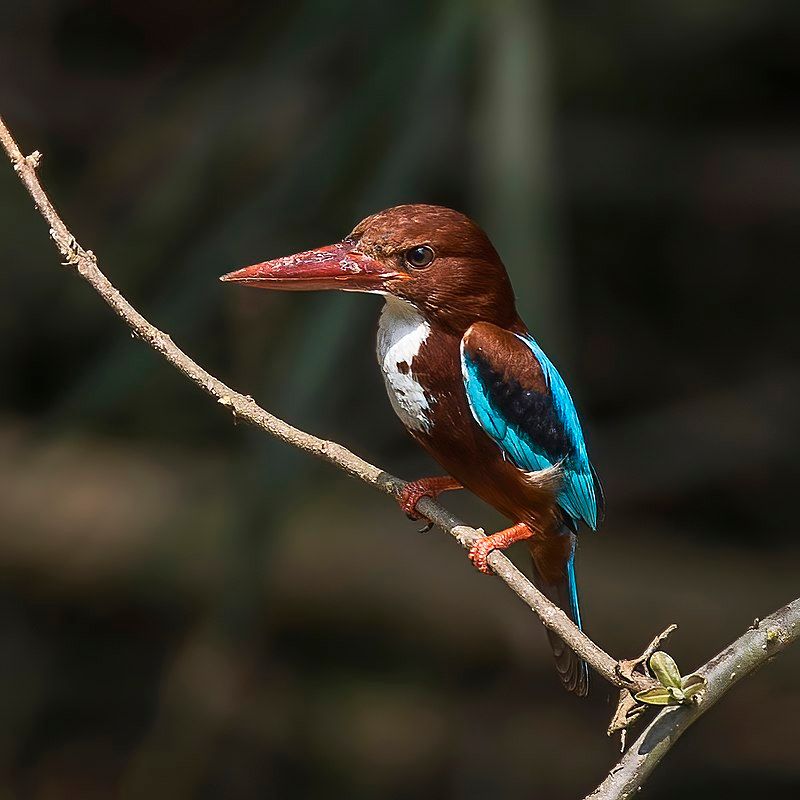
The white-throated kingfisher, also known as the white-breasted kingfisher, is a species of tree kingfisher that is widely distributed in several countries in Asia. It stretches from Sinai in the east to China and Indonesia in the west.
This kingfisher species is generally a resident of the region where it is found, meaning that they are usually found in the same area year-round. However, some populations may migrate over short distances in search of better food sources or weather conditions.
This bird species is known for its colorful plumage, with its distinctive white breast and blue wings. It is also known for its loud, high-pitched call that can be heard from far away.
This species of kingfisher feeds mainly on small fishes, insects, frogs, and crustaceans, which it catches with its sharp beak. It builds its nest in tree hollows or in the cavities of old buildings and generally lays two to five eggs.
| Kingdom | Animalia |
| Phylum | Chordata |
| Class | Aves |
| Order | Coraciiformes |
| Family | Alcedinidae |
| Genus | Halcyon |
| Species | H. smyrnensis |
18. Ayeyarwady Bulbul
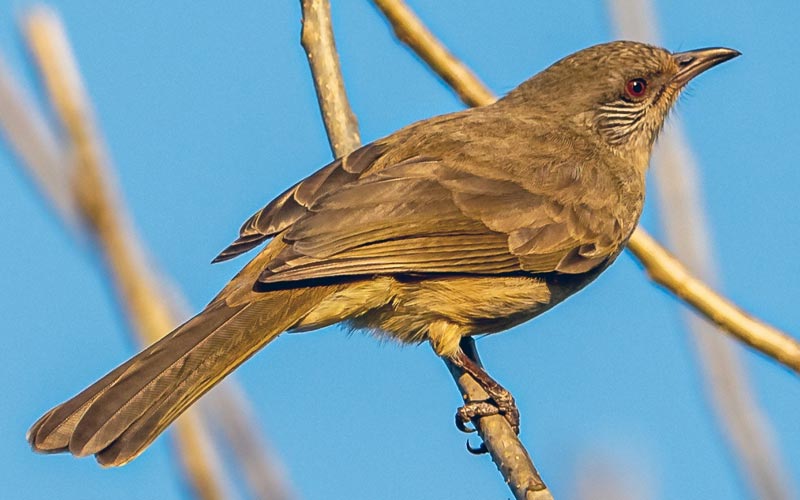
Source: ebird.org
The Ayeyarwady bulbul is a species of bird that is part of the bulbul family of passerine birds. It can only be found in Myanmar, meaning that it exists nowhere else in the world.
Its natural habitat is subtropical or tropical moist lowland forests, meaning that it prefers to live in warm, damp forests. Until 2016, the Ayeyarwady bulbul was thought to be the same as the streak-eared bulbul, which is another species of bulbul found in Southeast Asia.
However, after further examination, it was determined that the two species were actually distinct from one another, and the Ayeyarwady bulbul was given its own classification.
| Kingdom | Animalia |
| Phylum | Chordata |
| Class | Aves |
| Order | Passeriformes |
| Family | Pycnonotidae |
| Genus | Pycnonotus |
| Species | P. blanfordi |
19. Asian Openbill
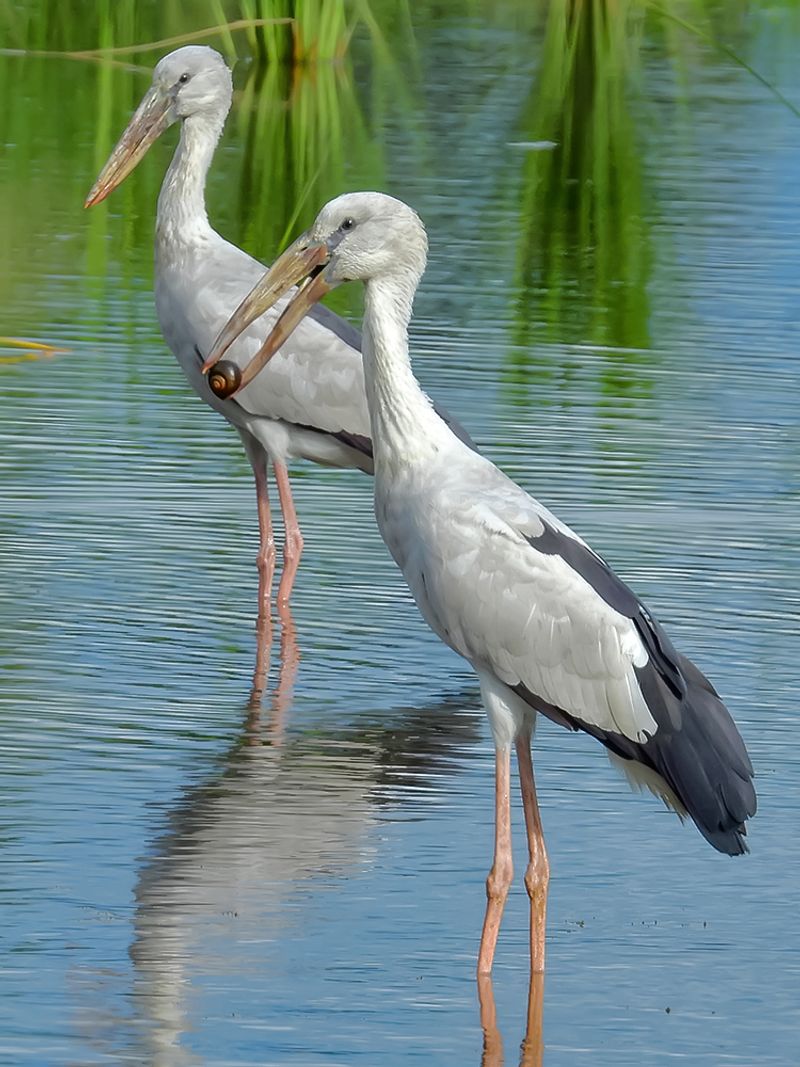
The Asian openbill stork is a large wading bird that is part of the stork family Ciconiidae. It is found mostly in the Indian subcontinent and Southeast Asia, making it a distinctive species in these areas.
It is easily recognizable due to its unique bill shape, which has a gap in the middle, giving it the name “openbill” stork. The bill is used to catch its prey, mostly aquatic creatures like crabs, mollusks, and other small aquatic invertebrates.
The Asian openbill stork is a large bird, typically measuring between 70-90 centimeters in length. It has a wingspan of between 140-163 centimeters and typically weighs between 1.2-2.2 kilograms.
It has mostly white plumage with black on its wings and tail, and its legs are gray or pink. In terms of its habitat, the Asian openbill stork prefers wetlands, rivers, and lakes. It is usually found in shallow waters, as it feeds on aquatic invertebrates.
It is known to migrate between India and Southeast Asia and is usually observed in large flocks. Overall, the Asian openbill stork is a distinctive species found mainly in the Indian subcontinent and Southeast Asia.
It is easily recognizable due to its unique bill shape and can be found in wetland habitats and shallow waters. It is usually observed migrating in large flocks and feeds on aquatic invertebrates.
| Kingdom | Animalia |
| Phylum | Chordata |
| Class | Aves |
| Order | Ciconiiformes |
| Family | Ciconiidae |
| Genus | Anastomus |
| Species | A. oscitans |
20. Red Collared Dove
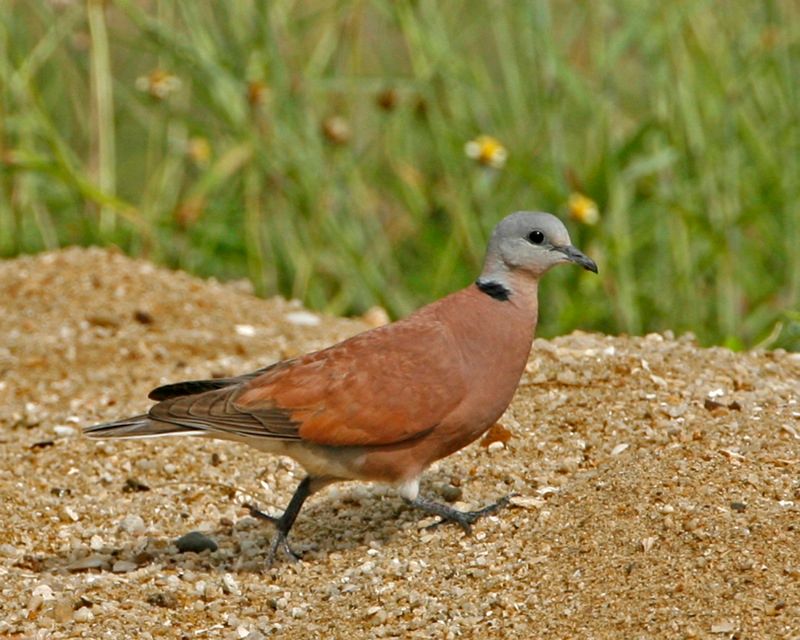
The red-collared dove is a small pigeon that is native to the tropics of Asia. It is also known as the red turtle dove and is easily recognizable due to the male’s striking plumage.
The male has a blue-grey head and a red-brown body, while the female has a much more subdued look. She is mostly pale brown, similar to the larger Eurasian collared dove.
This species is a successful resident breeding bird in its native habitat, and can also be seen in more northern climates during the summer months. They are commonly seen in parks and gardens, and make a pleasant sound, making them popular with birdwatchers.
| Kingdom | Animalia |
| Phylum | Chordata |
| Class | Aves |
| Order | Columbiformes |
| Family | Columbidae |
| Genus | Streptopelia |
| Species | S. tranquebarica |
21. Ruddy-breasted Crake
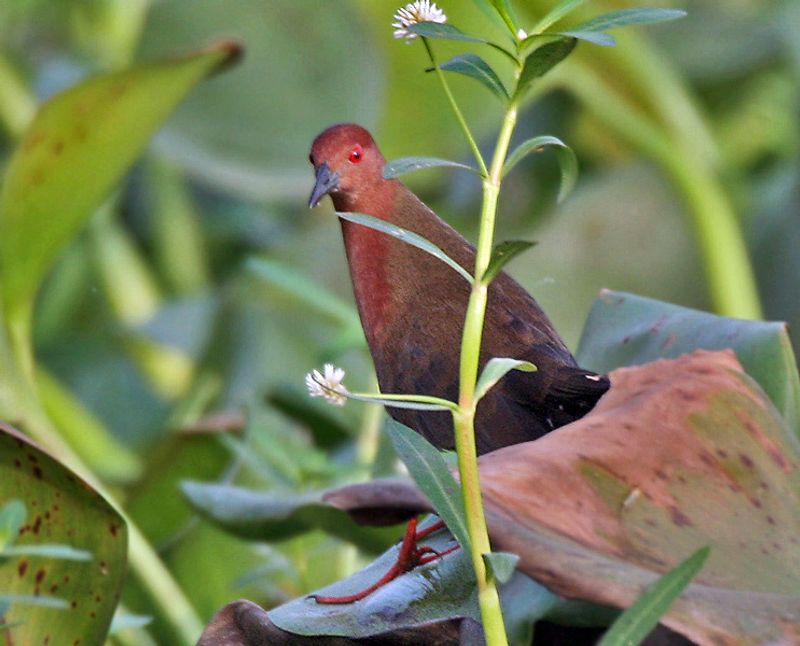
The ruddy-breasted crake, also known as the ruddy crake, is a member of the rail and crake family Rallidae. It is a waterbird that can be found in a wide range of wet environments, such as swamps, across South Asia and parts of East Asia.
Its breeding habitat stretches from the Indian subcontinent all the way east to South China, Japan, and Indonesia. The ruddy-breasted crake has a distinctive reddish-brown chest, which is how it got its name.
It is a medium-sized bird, about the same size as a chicken, and is generally a shy and elusive creature.
It is not a very social bird, preferring to be solitary and only occasionally seen in pairs or small groups. The ruddy-breasted crake feeds on aquatic insects, crustaceans, and small fish.
They hunt for their food by wading through shallow water or edges of swamps and rivers, using their long, sharp bill to spear or grab small prey. The ruddy-breasted crake nests close to water, in grassy areas or reed beds.
The nest is typically built on the ground and is made from grass and other vegetation.
The female will lay a clutch of 4-5 eggs, and both parents will take turns incubating the eggs until they hatch. The ruddy-breasted crake is considered to be a near-threatened species due to habitat destruction and pollution.
The destruction of wetlands in its range has had a negative effect on its population, leading to a decrease in numbers. Thankfully, conservation efforts have been put in place in some areas to protect these birds and their habitats.
| Kingdom | Animalia |
| Phylum | Chordata |
| Class | Aves |
| Order | Gruiformes |
| Family | Rallidae |
| Genus | Zapornia |
| Species | Z. fusca |
22. Purple Heron
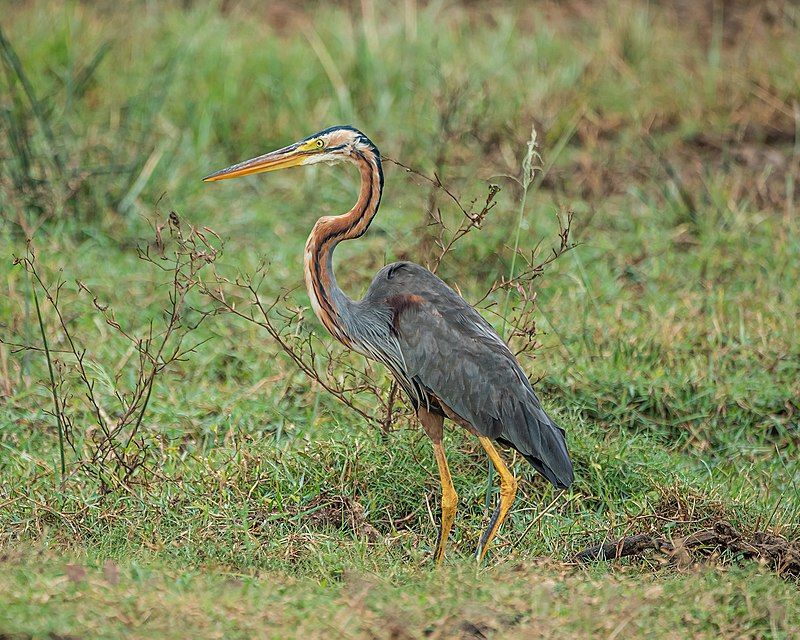
The purple heron is a species of heron that can be found in many parts of the world. It breeds primarily in Africa, as well as in parts of Europe and Asia. In Africa, the purple heron can be found in the central and southern parts of the continent.
It is also present in some of the southern and eastern portions of the Palearctic region, which includes parts of Europe and Asia. The purple heron is a migratory species, meaning that it will travel long distances from its breeding grounds to wintering grounds.
Its specific range and migratory patterns vary from region to region. In Africa, the purple heron may migrate as far as southern Africa during the winter months.
In Europe, it can be found as far north as Scandinavia and Scotland in the summer months. The purple heron prefers to inhabit wetlands, such as marshes, lakes, ponds, and rivers. It can also be found in wooded areas and agricultural fields.
The heron typically hunts for its food in shallow water, where it will stand motionless and wait for prey to come close.
This species of heron feeds on a variety of small aquatic life, including fish, crustaceans, insects, and amphibians.The purple heron is a striking bird, with a long neck and slender body. Its plumage is mostly grey and white, but its wings and tail are a deep purple color.
This species of heron is typically seen alone or in small groups, but it may also be found in large flocks during migration. The purple heron is a beautiful and graceful bird, and it is a pleasure to watch as it hunts and forages in its natural habitat.
| Kingdom | Animalia |
| Phylum | Chordata |
| Class | Aves |
| Order | Pelecaniformes |
| Family | Ardeidae |
| Genus | Ardea |
| Species | A. purpurea |
23. Common Moorhen
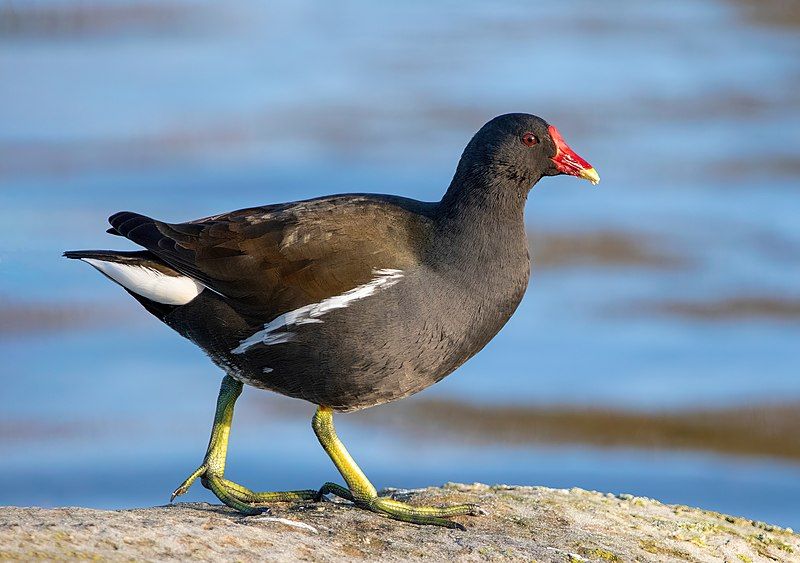
The common moorhen, also known as the waterhen or swamp chicken, is a bird species belonging to the rail family. This species is native to many parts of the Old World, including Europe, Africa, and parts of Asia.
Common moorhens are found in wetlands with abundant vegetation, such as marshes, ponds, and canals.
These birds are able to swim and dive under the surface of the water, making them well-suited to life in wetlands. The common moorhen is a medium-sized bird with a long, flattened bill and a red frontal shield on its forehead.
Its back and wings are dark brown in color, while its underside is greyish-white. It has short legs with long toes that are adapted for swimming.
In addition, its tail is short and its wings are rounded. Common moorhens are omnivorous, meaning they feed on both plants and small animals. Their diet typically consists of seeds, roots, leaves, insects, amphibians, fish, and crustaceans.
To feed, they often submerge their heads in the water to search for food. Common moorhens mate during the summer months and produce clutches of up to seven eggs.
The chicks are precocial, meaning they are able to feed and move around independently at a very young age. The common moorhen is an important species in wetland ecosystems, as it helps to keep aquatic vegetation in check.
It also provides an important food source for larger predators, such as foxes and owls. All in all, the common moorhen is a valuable species that helps to maintain the balance of wetland ecosystems.
| Kingdom | Animalia |
| Phylum | Chordata |
| Class | Aves |
| Order | Gruiformes |
| Family | Rallidae |
| Genus | Gallinula |
| Species | G. chloropus |
24. Javan Pond Heron
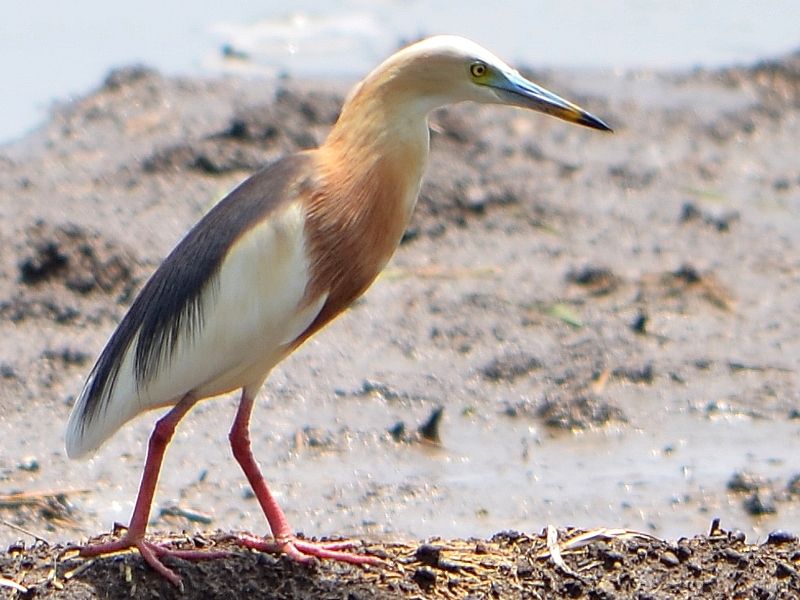
The Javan pond heron is a species of wading bird found in the heron family. It is native to Southeast Asia and has been observed in both fresh and salt-water wetlands.
This bird has a distinctive appearance, with white wings, a yellow bill with a black tip, yellow eyes, and yellow legs. The Javan pond heron has a varied diet, including insects, fish, and crabs.
This bird is typically 45 cm in length, and is a solitary hunter, stalking its prey in the shallow waters of its native habitat.
This species is known for its rapid strikes, using its sharp bill to capture its prey in a single motion. The Javan pond heron is an important part of the wetland ecosystem in Southeast Asia.
It plays an essential role in controlling pests, while also providing food for other animals such as fish, frogs, and turtles.
In addition, its presence also helps to maintain water quality by feeding on algae and other aquatic organisms. The Javan pond heron is a unique species that is deserving of conservation.
It is currently listed as a species of least concern by the International Union for Conservation of Nature. Despite this, the population of this species is declining due to habitat destruction and degradation of wetlands.
This is why it is important to take steps to protect this species and its habitat.
| Kingdom | Animalia |
| Phylum | Chordata |
| Class | Aves |
| Order | Pelecaniformes |
| Family | Ardeidae |
| Genus | Ardeola |
| Species | A. speciosa |
Conclusion
Birds in Kanchanaburi are an important part of the natural ecosystem.
They provide essential services, such as pollination and pest control, while providing visitors with a unique and beautiful wildlife experience.
From the mountains of Doi Inthanon to the lowlands of the Kwai River, Kanchanaburi is a great place to observe and appreciate the avian diversity of Thailand.